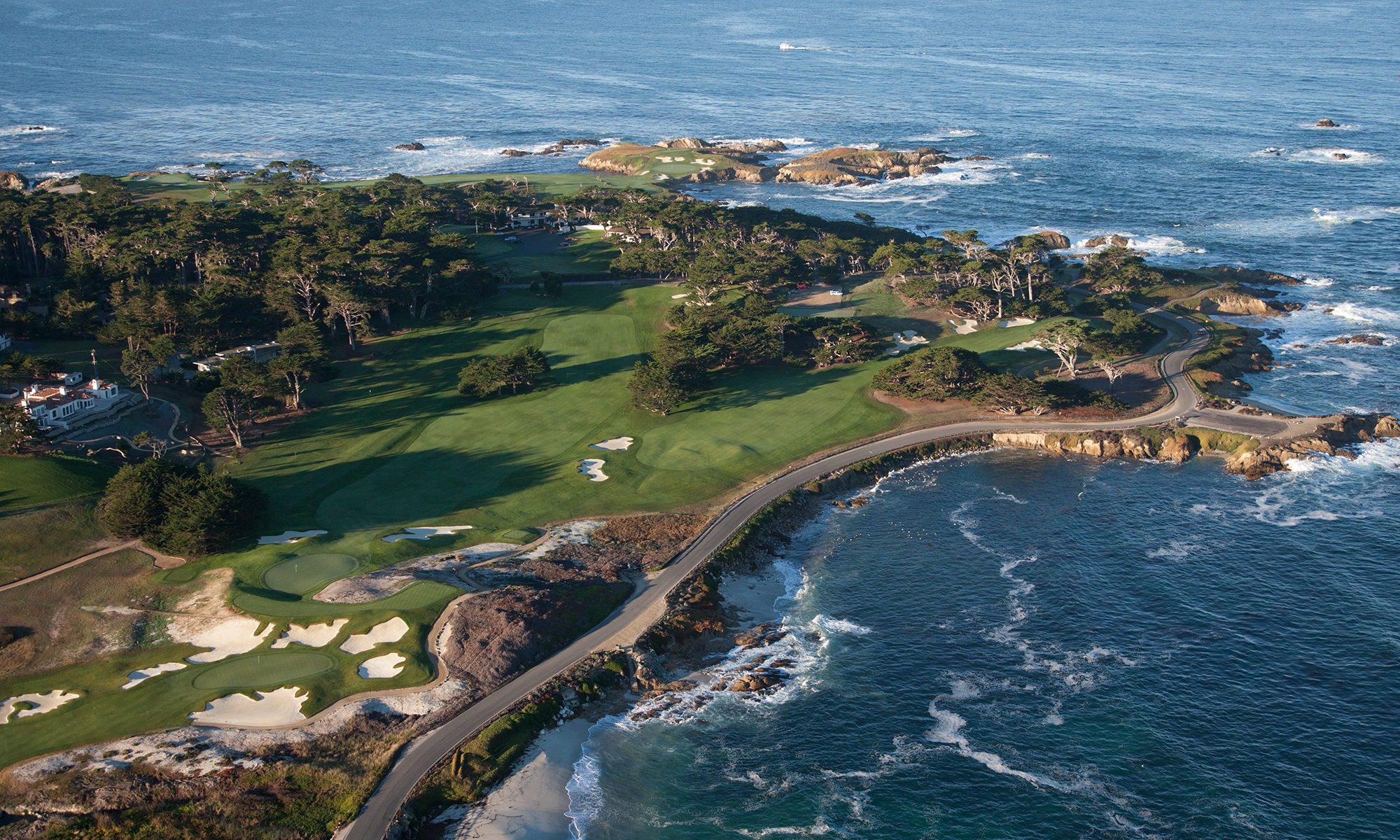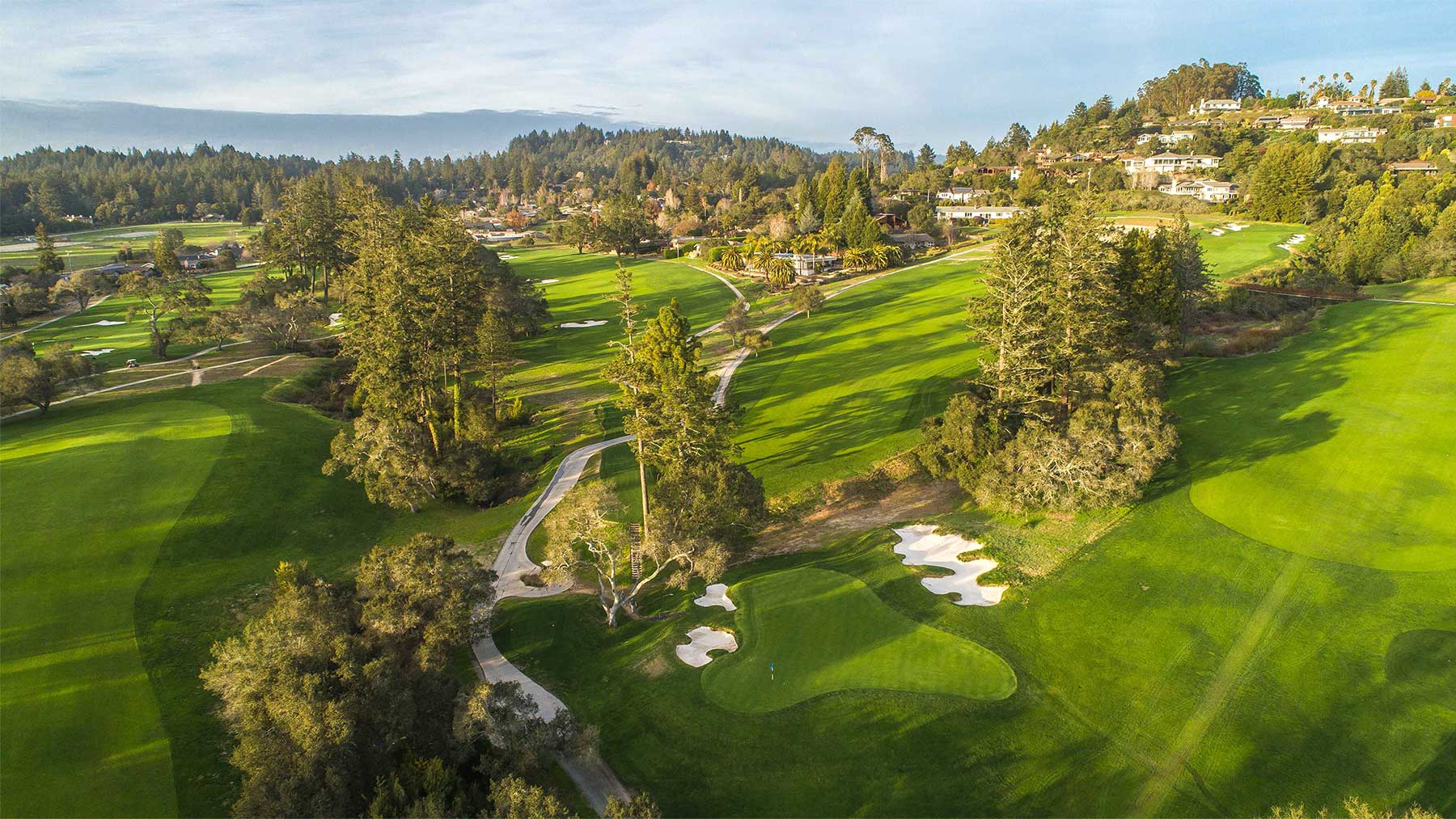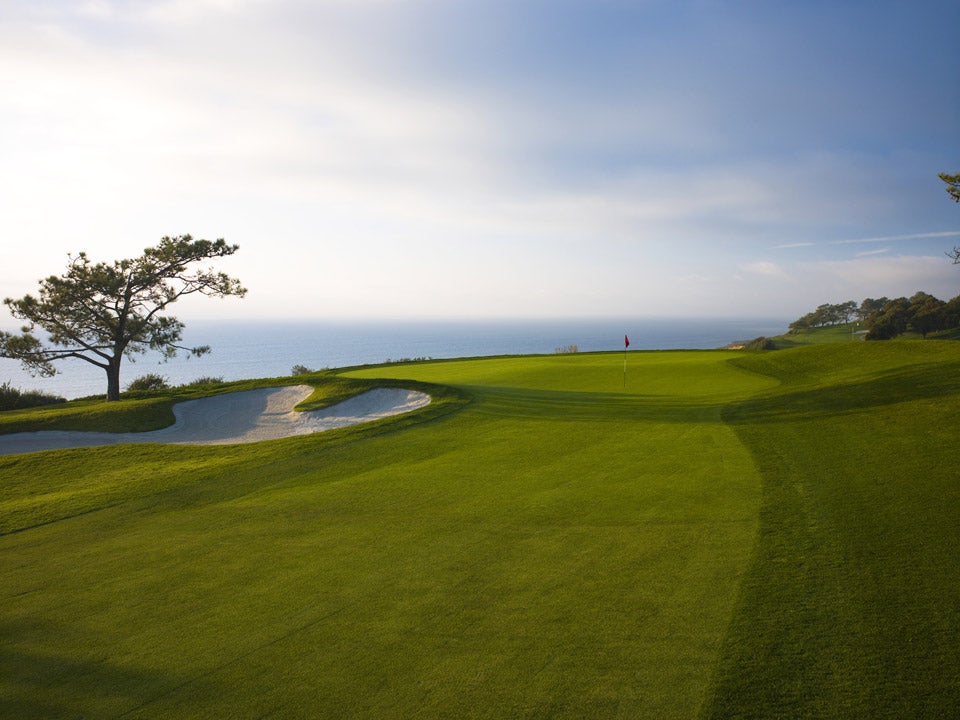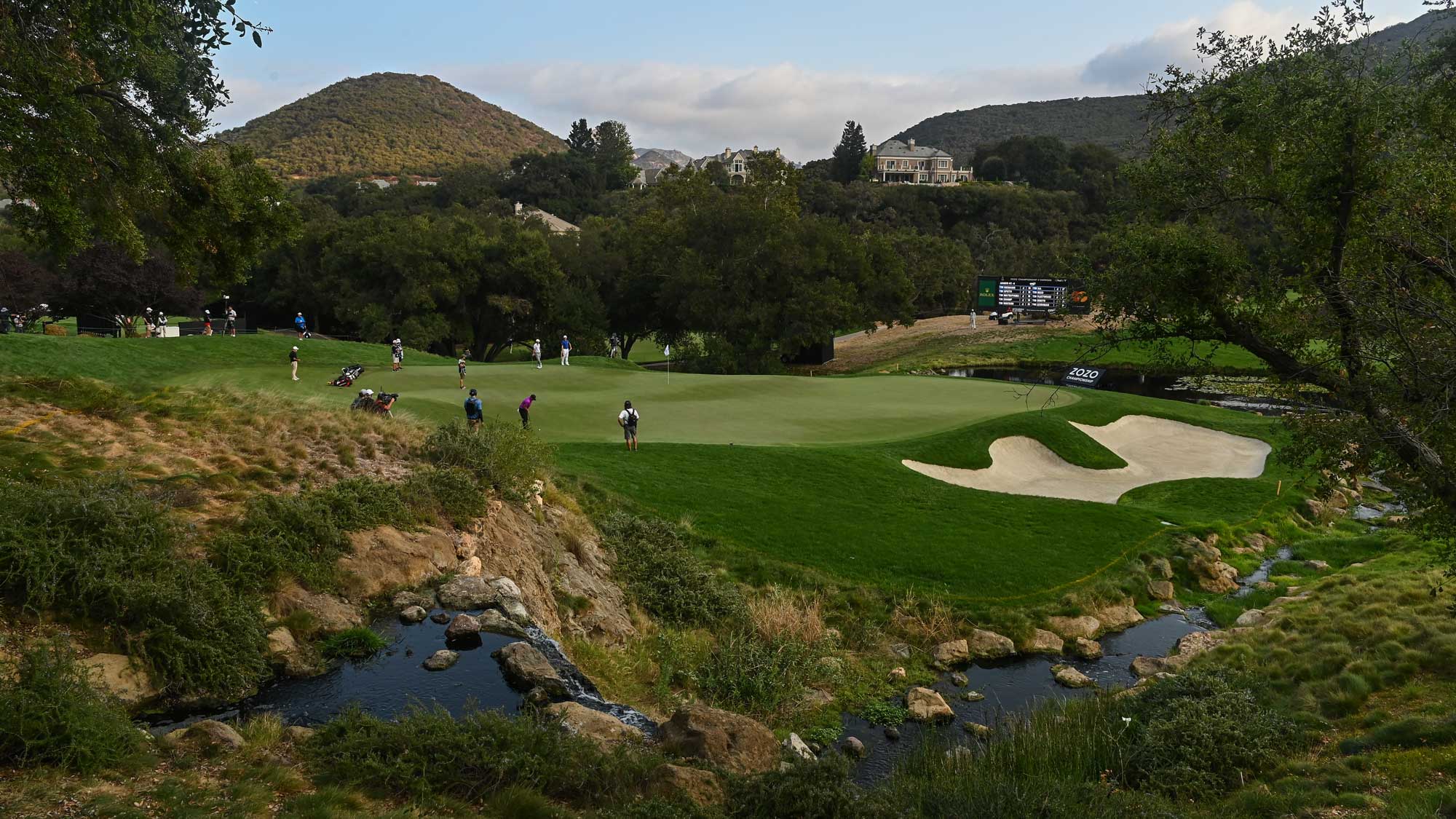
The 35 best golf courses in California (2022/2023)
SYMBOL GUIDE
1 = Top 100 Course in the U.S.
P = Public/Resort Course
V = Top 100 Value Course in the U.S.
M = Top 30 Municipal Course in the U.S.
Ed. note: Some courses were omitted from our rankings because they did not receive enough votes.
1. Cypress Point (Pebble Beach) [1]
It’s almost inconceivable that land this stunning was made available for golf. For the lucky few who get to play here, they enjoy one of the game’s most inspiring walks as Alister MacKenzie’s design effortlessly transports the player around the diverse property. The iconic par-3 16th, which extends into the churning Pacific, is the game’s most dramatic and photographed hole, but there are endless other highlights, from the forested portion to heaving dunes to its famed jagged coastline. MacKenzie extracted the best from the land in part by breaking the “rules” and having back-to-back par-5s on the front and back-to-back par-3s on the back. The drivable ½-par 9th is another standout with its angled green toward play.

2. Los Angeles – North (Los Angeles) [1]
Gil Hanse and team restored George Thomas’s classic to perfection in 2010. Bunkers were reshaped and relocated, fairways widened and a natural barranca was brought back into play as a strategic hazard. Arguably America’s premier urban design, LACC North hosted the 2017 Walker Cup and design aficionados can’t wait for the 2023 U.S. Open. As Hanse says, “The course enjoys a perfect sense of place and balance.” Two shotters like 3 and 10 will challenge the players with uneven fairway lies but its superlative collection of one-shot holes will also prove quite a test, even with ball in hand and a perfect lie/stance.
3. Pebble Beach (Pebble Beach) [1, P]
The first great American public oceanside course, Pebble benefits from an ingenious routing that brings the player to the ocean’s edge, then onto much higher ground, before returning to the cliffs for the climactic final two holes. Even today, with gobs of world class courses having been built in the past 100 years, no more thrilling, spectacular stretch exists than holes 4 through 10. Additionally, does any walk compare with that final stroll up the iconic par-5 18th as it curves left around Carmel Bay?! Hard for a course this well known to exceed first-time expectations — but it does.
4. Riviera (Pacific Palisades) [1]
The value that an architect provides is highlighted here in technicolor. Built in a narrow canyon, there was no reason to hold high hopes for this course. Yet what emerged, courtesy of George Thomas and Billy Bell, is one of the game’s strategic design marvels. Together, the designers took bunker configuration and angled greens to new heights in the 1920s. As proof of their magical skills, look no further than Riv’s 311-yard, par-4 10th. Thanks to the inspired positioning of the bunkers and the angled green, options abound on how to card a big number on this tiny hole. Thomas’s famous quote — “strategy is the soul of the game” — manifests itself at Riv.
5. San Francisco (San Francisco) [1]
A.W. Tillinghast built his most artistic collection of bunkers at this low-key Bay Area hideaway that avoids publicity as steadfastly as its neighbor the Olympic Club embraces it. Known as the Duel Hole, the drop-shot par-3 7th may be the course’s most famous hole, but its par-4s, including the 2nd, 3rd, 10th and 12th, are the real headliners.

6. California Golf Club of San Francisco (South San Francisco) [1]
For most of its 80-year history, the Cal Club, as locals call it, served up a tight though well-regarded course, enhanced by its association with Ken Venturi. Following a 2008 Kyle Phillips re-do that was part restoration and part redesign, many feel this private course is equal to any in California north of Cypress Point. Situated on the side of a hill, Cal Club is guaranteed to catch any wind that is about. Add in fescue fairways and the site’s broad slopes and you have a course whose asks change daily. Even in calm conditions, the mix of short grass, sprawling bunkers and cypress trees provide constant photo opportunities. When you discover the design plays as good as it looks, you have something special.
7. Valley Club of Montecito (Montecito) [1]
Designed by Alister MacKenzie with Robert Hunter overlooking construction, The Valley Club oozes charm. The holes don’t bully the player and length isn’t the issue but approaching these greens from the optimal side of the fairway is paramount, given the firmness of the playing surfaces that club routinely achieves. Look no further for proof than the first two greens and how they are angled to reward play from the riskier, left side of the fairway. The only thing missing is yardage markers, but only because the club doesn’t believe in them. Refreshing to find a place where the game is played by feel, not analytics.

8. Pasatiempo (Santa Cruz) [1, P]
Alister MacKenzie calls Pasatiempo the finest course he ever built. Unlike Cypress Point, just an hour south, Pasatiempo sits slightly inland, but its high points offer views of the Pacific and the entire routing, with its giant paw-print bunkers and large, undulating greens, make plain the influence that this course had on MacKenzie’s later work at Augusta National. Charms and challenges abound, from the long, uphill par-3 3rd to the par-4 16th, a humpbacked dogleg with a second shot that plays over a chasm to a wild and winning three-tiered green. Some nitpickers grouse that the course is pinched by homes. But one of those houses belonged to MacKenzie, who chose to reside beside the par-5 6th.
9. Olympic – Lake (Daly City) [1]
It’s always a delight to find a course that rewards the lost art of shaping shots. The 4th hole, for instance, features a reverse-camber fairway: the hole swings right to left but the fairway tilts left to right, mandating a draw from the tee. The next hole, a dogleg right, calls for a fade. Recent clearing has helped to highlight the stunning nature of the cypress trees that line this hillside overlooking Lake Merced. Its famous 5-5-short 4 closing stretch produced another climactic finish at the 2021 U.S. Women’s Open. Kudos to William Watson, who might well be the least appreciated important architect from the Golden Age.
10. Monterey Peninsula – Shore (Pebble Beach) [1]
Once a ho-hum layout that languished in the shadow of its famous 17-Mile Drive neighbors, the Shore Course started drawing notice in 2004 after the iconoclastic architect Mike Strantz built 12 new holes and overhauled six others. Strantz said his goal was to make players “dance among the cypress.” But his routing, which opens and ends amid the pines, also takes advantage of a vast expanse of coastline, with fairways fringed by wispy native grasses, and dramatic rock outcrops framing several greens and tees. In 2010, five years after Strantz’s passing, his work gained even greater recognition when the Shore Course joined the rota of the AT&T Championship.
11. Bel-Air (Los Angeles) [1]
A George C. Thomas classic that winds through the canyons overlooking Los Angeles. Great architects had tinkered with Bel-Air over the years, but Tom Doak’s recent restoration took out the modern gimmicks and more than 30 bunkers, bringing Bel-Air back much closer to its original design. What hasn’t changed: the clubby atmosphere on the patio, that stunning walk over golf’s most famous suspension bridge and a back nine showcasing what Ken Venturi called some of the best long par-3s in the world.

12. Monterey Peninsula – Dunes (Pebble Beach) [1]
Everything old is new again. Working with the original Raynor routing, wunderkinds Tim Jackson and David Kahn brought to fore the rugged features of a forest-meets-sea landscape on a reborn course that boasts majestic dunes, expansive sandy wastes and greens of wildly varied size and contour. Formerly straight fairways now sashay gracefully with the coastal terrain, and the par-3s, long a strength, have grown remarkably great. They include the hard-along-the-water 14th, which plays over the waves and is such a striking sight, tourists often stop to spectate from an overlook on 17-Mile Drive.
13. Spyglass Hill (Pebble Beach) [P]
14. Meadow Club (Fairfax)
15. Wilshire (Los Angeles)
16. Rustic Canyon (Moorpark) [P]
17. Stone Eagle (Palm Desert)
18. Diablo (Diablo)
19. The Quarry at La Quinta (La Quinta)
20. San Diego CC (Chula Vista)
21. Lake Merced (Daly City)
22. Hilcrest (Los Angeles)

23. Torrey Pines – South (La Jolla) [P, M]
24. Lakeside (Burbank)
25. Madison Club (La Quinta)
26. Rancho Santa Fe (Rancho Santa Fe)
27. PGA West – TPC Stadium (La Quinta) [P]
28. La Purisma (Lompoc) [P]
29. La Jolla CC (La Jolla)
30. Los Angeles – South (Los Angeles)
31. The Preserve (Carmel-By-The-Sea)
32. Mayacama (Santa Rosa)
33. Martis Camp Club (Truckee)

34. Sherwood (Lake Sherwood)
35. Orinda (Orinda)
How we rank our courses
For the course rankings lists, each panelist is provided a list of hundreds of courses and “buckets,” or groupings. If they believe the course to be among the best in its category (World, U.S. Value, etc.), they check the corresponding box to place it in a specific bucket. Panelists are also free to write in courses they felt should have been included on the ballot. Points were assigned to each bucket; to arrive at an average score for each course, we divide its aggregate score by the number of votes. From those point tallies, the courses are then ranked accordingly.
The key to the process is the experience and expertise of our panel. Hailing from 15 nations and all the worldwide golf meccas, each of our 117 handpicked panelists has a keen eye for architecture, both regionally and globally. Many of our panelists have played more than 1,000 courses in 20-plus countries.
Because we don’t prescribe a set method to assess courses as other ranks do, no one opinion carries the day — our rank is a democracy. Some panelists believe that enjoyment is the ultimate goal, and thus prioritize design attributes such as width and playing angles, while frowning on upon having to constantly hunt for balls in thick rough. Other panelists value challenge and the demands of hitting every club in the bag. Still others consider a course’s surroundings and overall environment of paramount importance, thereby emphasizing the setting and naturalness of the course. In the end, allowing raters to freely express their tastes is what produces the desired eclecticism in our Top 100 lists.
Panelist integrity is vital. Voters with any ties or associations to eligible courses must flag such conflicts. Panelists also know not to let the quality of their play influence their ballot — same for a luxe experience or clubhouse. While opulence may make for a more a memorable outing, it’s not what GOLF’s course lists are about. Our focus is on design and architecture. We study the course, not the trappings around it.
Original article by GOLF’s Course Raters and Ran Morrissett on Golf.com


